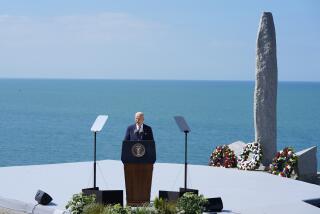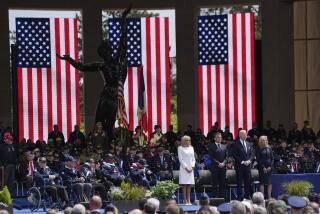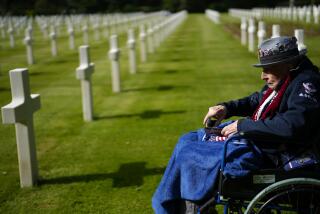UNDERSTANDING D-DAY : THE INVASION OF NORMANDY
Success on “the longest day” was a giant step on the road to destroying Nazi Germany. It allowed Allied ground forces to start their drive toward Berlin. The invasion, combining mostly U.S., British and Canadian forces and code-named Operation Overlord, marked the beginning of the end of the Hitler regime.
THE COMMANDERS
Dwight D. (Ike) Eisenhower Named supreme allied commander, not only because military abilities, but also because of his political skills. Made final decision to launch the invasion despite severe weather conditions. “I am quite positive that the order must be given (not to postpone).... I don’t like it, but there it is.... I don’t see how we can do anything else.” --Eisenhower to his generals, June 4, 1944
Erwin Rommel Charged with strengthening German defenses. Believed invasion must be stopped on beachesbecause once Allieds Allies were inland, their air superiority, larger numbers and greater industrial production would defeat Germany. “Believe me, Lang, the first 24 hours of the invasion will be decisive.... For the Allies, as well as Germany, it will be the longest day.” --Rommel to his aide, April 22, 1944
PREPARING FOR THE INVASION
Channel Crossing: Drive and Deception
Central to D-day success is keeping secret the invasion target. To that end the Allies invest a great deal of effort convincing Germans landings will take place at Calais. Allied convoys converge at “Piccadilly Circus” and 255 minesweepers clear lanes through German minefield. As invasion force heads toward Normandy, other vessels sail toward Calais, towing special balloons that produce radar echoes similar to those of troop ships. British bombers drop strips of aluminum foil to produce other false radar images, and dummy paratroopers are dropped.
Why Normandy? * Close enough for England-based planes to provide air cover * Beaches large and flat enough to allow troops to be landed and supplied * Hinterland big enough to allow beachhead development * Not heavily defended * Nearby ports, essential to post-invasion supply
INVASION COUNTDOWN
On June 3, the invasion force sailed, expecting a June 5 landing. But the weather was deteriorating.
June 4 04:00: Meteorologist tells Eisenhower June 5 will be overcast, stormy 06:00: Eisenhower postpones landing 07:00: Rommel leaves for Germany to see Hitler, celebrate wife’s birthday 21:30: Eisenhower told bad weather will break on June 6 21:45: Eisenhower decides invasion will be June 6 23:00: All ships have received orders to resume sailing 24:00: Convoys begin to form
June 5 03:15: Allied generals receive weather briefing 04:15: Eisenhower makes final “go” decision 19:00: Eisenhower visits American airborne troops 22:00: Airborne forces don chutes, equipment 23:00: Airborne troops take off
June 6 00:15: Invasion begins as British paratroopers land 03:00: Allies begin aerial bombardment 03:03: Minesweepers finish sweeping water nearest the beaches 05:30: Naval bombardment begins 06:30: First landing, at Utah Beach
BATTLE AT THE BEACHES
The entire front, from Utah Beach in the west to Sword in the east, covers about 60 miles--about the distance from Venice Beach to San Clemente. The famous beach code names identified with D-day didn’t actually refer to beaches, but were names given to landing areas. Within each landing area were the assault beaches, where the troops landed.
American Airborne After initial confusion, 13,000 troops secure vital roadways and villages that will help invasion move off Utah Beach; they also provide flank protection.
UTAH Strong current and poor visibility cause Americans to land in wrong sector but against light defenses. They quickly move inland and make contact with American airborne troops.
OMAHA Americans engage in fiercest fighting of the day. Assault breaks down as all but a few first-wave troops land in wrong places. Attack take place over a wide beach and heavily defended bluffs, and moves inland by noon.
GOLD Armored forces, landing ahead of infantry, lose all but one tank. British move off beach and establish a five-square-mile lodgment but fail to connect with Americans on Omaha.
JUNO Bitter opposition surprises Canadians, but by mid-morning they capture local village and set up headquarters. Armored units arrive on time; contact is made with British.
SWORD British secure beaches by 10 p.m. Contact with airborne further secures bridges to east. Only counterattack of day repulsed, shredding German tank division.
British Airborne Just after midnight, 8,000 troops begin arriving East of Sword Beach. They quickly destroy some targets, capture key bridges and secure Eastern flank. Air Forces Invasion succeeds in part because of air-space control over and around beaches. Allied air forces have 8,000 combat aircraft; Germans fewer than 500. Allies fly 14,000 sorties, the Germans 250--mostly at action’s fringes.
Smoke on the Water Naval bombardment ends just before landings begin. Short duration of barrage and heavy fortification helps defending guns survive. Three-quarters of the warships are British. Not Even a Clue German defenders are unaware of huge invasion force until it is in front of them. Key factors: * Miserable weather * Bombing has destroyed much of German radar capability * Cloud cover makes aerial reconnaissance difficult * Naval patrols are not dispatched due to weather * Rommel, convinced that tides and weather are unfavorable, is in Germany
No Tank Problem German panzers play no effective role. Only division nearby is sent east toward British airborne, then ordered to switch direction and counterattack north to gap between Juno and Sword beaches; 13 tanks are immediately destroyed. When survivors withdraw, they have lost 70 of 124 tanks.
“BLOODY OMAHA”: Americans Meet Savage Defense
Americans encounter fiercest resistance of the day. All but a few first-wave troops land in wrong places. Germans have the beach covered with everything from artillery to small arms from a honeycomb of strongpoints, gun pits and an extensive trench system. Allied intelligence fails to note presence of more and better trained troops than are expected.
Omaha Gantlet First-wave invaders navigate rings of an Omaha hell--covering more than 200 yards of treacherous beach before running into a concrete seawall. Enemy defenses claim 2,400 U.S. killed, wounded or missing in the first 24 hours.
* Belgian gates: Seven-by-10-foot steel frames with waterproof mines carrying 12 pounds of TNT * Wooden stakes: Eight to 10 feet long, angled seaward, mined * Hedgehogs and ramps: Three six-foot steel bars welded together at their centers; interspersed with wooden ramps that point toward shore. These ramps are designed to impale retreating landing craft * Concrete seawall * Barbed wire * German gun positions: As part of the Atlantic Wall, the Germans built large coastal batteries, buried in the cliff tops. These are supplemented by fortified gun positions inland. Deadliest of the German guns, the 88-millimeter cannon is able to destroy tanks up to 2,000 yards away. It is particularly lethal against troops when firing air-burst shells.
1. American ships unload 11 miles offshore; troops in boats four hours before landing, many becoming seasick. 2. Tanks launched 5,000 yards off shore, 27 of 32 sink in heavy seas; 40 of 72 boats carrying artillery capsize. 3. Many boats ground before reaching beach; troops wearing 70 pounds of equipment jump into deep water and drown. 4. On beach, wind and tide force landing boats together, allowing Germans to concentrate fire in small areas. 5. Many wounded, unable to crawl faster than a swiftly rising tide, drown. 6. Massive German cross-fire pins invaders behind obstacles; one-third of engineers sent to clear lanes through obstacles are killed. Concrete seawall, first real protection, is in triple cross fire: machine guns and artillery from sides, small arms from front, mortars overhead.
*
Sources: “D-Day, June 6, 1944, The Climactic Battle of World War II,” by Stephen Ambrose; “Decision in Normandy,” by Carlo D’Este; “Overlord,” by Max Hastings; “The Longest Day,” by Cornelius Ryan; “The Invasion of France and Germany,” by Samuel Eliot Morison; “D-Day: Operation Overlord,” Smithmark Publishers; “Illustrated History of World War II,” The Reader’s Digest Assn. Ltd.; “Remembering Omaha’s Ordeal” in World War II magazine, May, 1994
More to Read
Sign up for Essential California
The most important California stories and recommendations in your inbox every morning.
You may occasionally receive promotional content from the Los Angeles Times.










